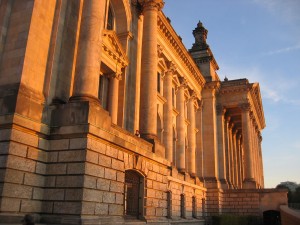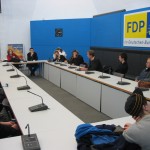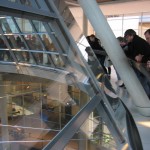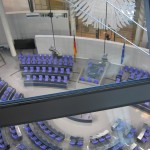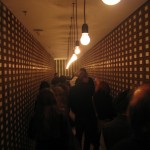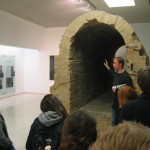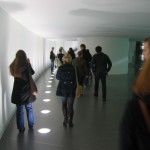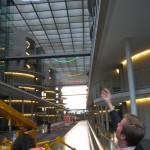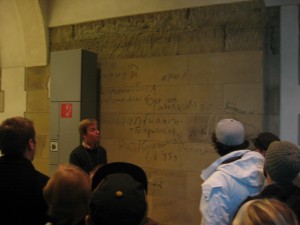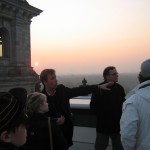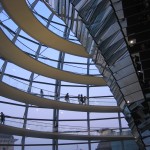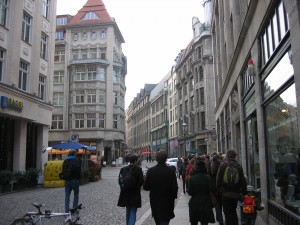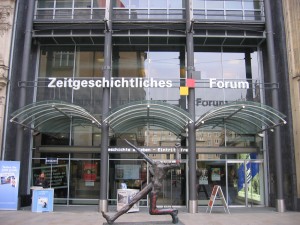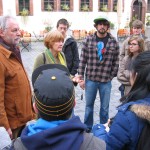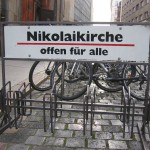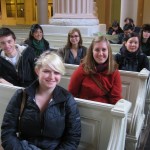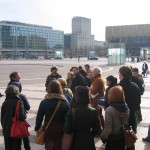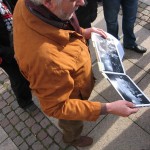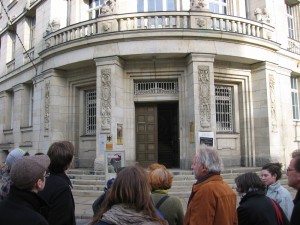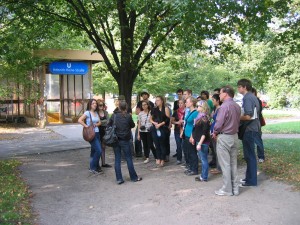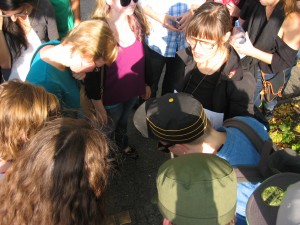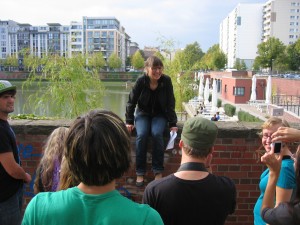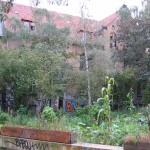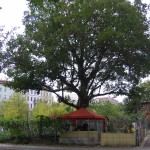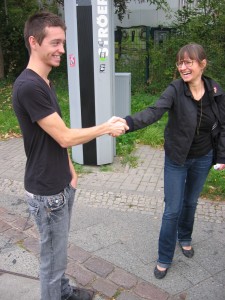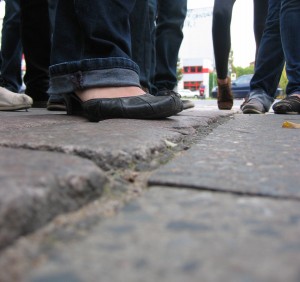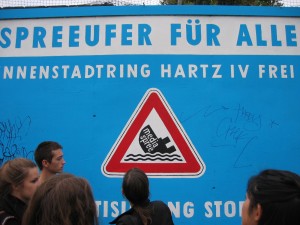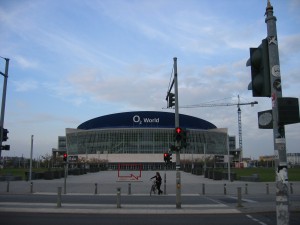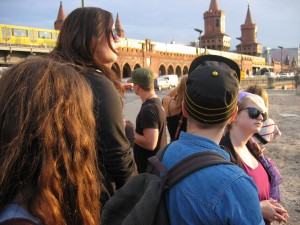A visit to the Reichstag
Our activities this week included a tour of the Reichstag (the German parliament building).
Our guide was Ulli Finkenbusch, who works for the Free Democratic Party (FDP). After an introductory discussion about some important political issues facing Germany, we took a tour of the building, beginning with the mezzanine level.
On the lower level of the main parliament building, we viewed an artwork by Christian Bolstanski (left), consisting of metal boxes with the names of all the German Parliament members since 1919. We also saw the remains of the tunnel through which the arsonist who set fire to the Reichstag in 1993 is supposed to have entered building.
We then traversed the underground walkway connecting the Reichstag with the parliament meeting rooms and offices in the Paul-Löbe-Haus.
On our way back through the Reichstag, we glimpsed graffiti left by Soviet soldiers in 1945, which has been preserved as part of the integral history of the building.
Our final stop was on the roof, where Ulli pointed out several of the city sights that are visible from there, and we enjoyed a beautiful sunset!
A trip to Leipzig, epicenter of the Wende
This Friday we took a day trip to Leipzig to learn more about the events that led to the Wende – the momentous “turn” or “change” in 1989 that eventually led to the reunification of Germany.
Our first stop was the Zeitgeschichtliches Forum, a museum that focuses on the the resistance movement that was centered in Leipzig in the 1980s, and its eventual results in the “peaceful revolution.”
Afterwards, historians Dorothee Wierling and Bernd Lindner shared their expertise with us on the streets of Leipzig itself, taking us step-by-step along the route walked by the protesters here in 1989. The resistance movement first centered on the Nikolaikirche, a church where politically-charged “peace prayers” had already been taking place for several years. In 1989, attendance began to soar as people joined the movement to demand change.
As the number of protesters grew week by week, they dared to walk further and further along the “Ring” avenue that encircled the city center. Herr Lindner, who took part in the protests, helped us retrace their steps. (He augmented the experience with photos from a book he helped co-author – right.)
By November of 1989, 70,000 protesters were marching together peacefully through the streets of Leipzig. One of the last sites to be incorporated into their route was the Runde Ecke – the building housing the central offices of the Stasi.
As we approach the anniversary of the fall of the Wall, it’s good to remember that this revolution did not begin in Berlin, but in Leipzig. The capital is often privileged in the narrative of the Wende, but it couldn’t have happened without the courage of the protesters in this other key city.
A walk through our Kiez with Manuela Mangold
Manuela Mangold, a long-time Kreuzberger, gave us a fantastic tour of the students’ “Kiez” in Berlin on Tuesday afternoon. Kiez is a local word meaning “neighborhood,” but it denotes not just a district of the city (in this case, Kreuzberg), but one’s immediate, local surroundings — the place where everyday life is lived.
We started our tour at the Heinrich-Heine-Strasse U-Bahn station, the stop where the students regularly get onto the subway. During the time when Berlin was divided, it was a border crossing used mainly for commercial traffic. Below, the subway station was a “ghost station” — because the wall ran in a zig-zag manner from roughly the southeast to the northwest, trains going from this part of West Berlin would pass under East Berlin on their way to other parts of West Berlin would pass through a completely darkened (and sometimes guarded) station.
Next on our tour was an example of Stolpersteine (“Stumble Stones”), an art project begun in Cologne, but which has left its mark all over Berlin. A form of Holocaust memorial, it marks where victims of the tragedy once lived. People are meant to “stumble” over these on their daily walks, a constant reminder of the importance of remembering the Holocaust, and its impact on life here.
We continued with a look at the path of the Berlin Wall and death strip. Manuela is sitting right between former East and West in the picture! As in most of Berlin, it’s been restored so nicely now that barely a trace of the division remains.
Oppositional culture has been a huge part of Kreuzberg’s identity since the 1970s. Here are two examples of “squatter” culture — both built right up against the Wall. One is a famous house squat, and the other a garden built right in the shadow of the wall, in what was technically East German territory!
We continued along the path of the wall, which is (in some places) marked by a strip of brick set into the ground. (Dominic represented East Germany, shaking hands with a West Berliner!)
Leaving our Kiez and crossing the Spree River, we continued on to talk about the politics of development along the river banks, another area where squatters and other oppositional movements have traditionally made their homes. Now big developers are buying up large swaths of property, driving up rents and bringing a whole new feel to the neighborhood, garnering vehement protest from locals. One glaring example of this is O2 World, a large concert venue whose undeniably corporate aura conflicts tangibly with its surroundings. Its VIP entrance along the river was heavily protested, but got built anyway.
We ended our tour at the Oberbaumbrücke, which was also divided by the Wall. Now, as you can see in the background, the U1 train line can run all the way across it again!
Our Kiez is in some ways the perfect spot for the students, sitting uncomfortably amidst the former East and West, scarred with layers of memory and history – and still transforming before our eyes.
tags
the author
I'm a doctoral student at CUNY Graduate Center. I'm thrilled to be teaching the CHID Berlin program with Prof. John Toews! You can contact me at naraelle [at] gmail.com, or find out more about me at www.naraelle.net.
Blogroll
- Annie Holden's blog
- Cassie Hoeprich's blog
- Dominic Barrera's blog
- Janet Williams's blog
- Mariah Alderete's blog
- Melissa Au's blog
- Robert Hampton's blog
- UW Students Study Abroad Our students Natalie and Cassie are contributing to the official IPE student blog this fall!



